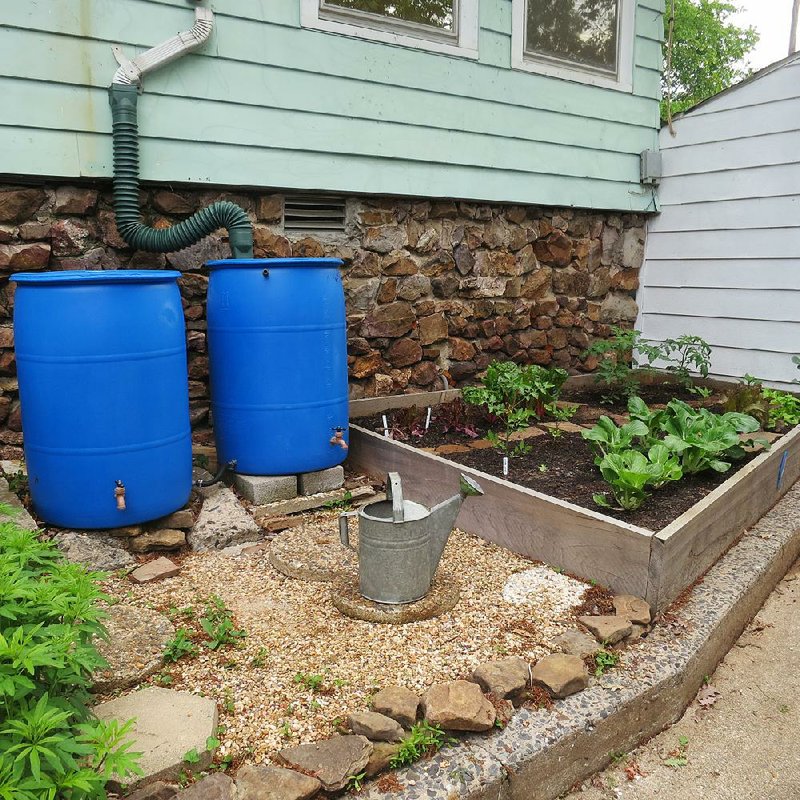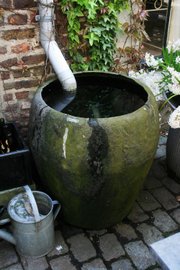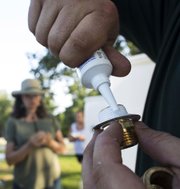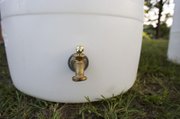Shout down my rain barrel,
Slide down my cellar door,
And we'll be jolly friends
Forever more!
The old playground tune goes back to when nearly every house had a rain barrel -- a whiskey or beer barrel, maybe. Lots of things used to be shipped in barrels of the kind crafted by yesterday's barrel-maker, called a cooper, of wood staves and iron bands.
Another timeless tune describes exactly how a rain barrel works, positioned under the drain spout to catch rain water that runs off the roof:
Down came the rain,
And washed the spider out.
The rain barrel collects water to use in all the ways that made the old rain barrel a familiar sight. Water the garden, wash the dog, have a soft-water shampoo, splash the dirt off muddy bare feet, and flush out the itsy-bitsy spider.
The basic idea is just that simple: something to catch water.
In use since ancient times, rain barrels declined along with the old-time hand pump over the kitchen sink. City plumbing made it easy to flick a faucet. In fact, Little Rock was among cities that once banned rain barrels as a needless source of mosquitoes, says Raven Lawson of Central Arkansas Water.
But times have changed in several ways. Plastic barrels have taken the common place of wood that eventually leaks, and new concerns add to the reasons for having a rain barrel.
Environmentally, it makes no sense to waste water. A rain barrel can provide the average homeowner 1,300 gallons of free water through the summer, according to the Environmental Protection Agency.
Besides, water that pours off the roof can lead to drainage problems around the house. And a screen over the barrel swats the bug problem.
A rain barrel "can take the pressure off your well or municipal water system, save money and protect the environment," according to Natural Life magazine. It can be the answer in case of a watering ban, according to Organic Gardener.
Drought-dry California
imposed watering restrictions earlier this year. The current movie Mad Max: Fury Road envisions a world crazed for lack of water, and not a rain barrel in sight.
One answer is to buy a rain barrel. Ready-to-go rain barrels cost from under $100 to several hundred dollars at various home and garden stores, depending on size and appearance.
Today's store-bought rain barrel could look like an age-old wine cask, but actually be plastic. It could be a barrel of any bright color, or no barrel at all -- could have the appearance of a terra cotta urn, a planter, a boulder, a stone wall.
But for the do-it-yourselfer -- for the rain-barrel-seeker on a budget -- the handy option is to make one.
The basic idea is a barrel with a spigot at the bottom, an overflow spout near the top, a screen or some sort of cover, and the whole thing up on a platform: a couple of cinder blocks will do.
"There are dozens of ways to make rain barrels," says Uta Meyer of Audubon Arkansas in Little Rock.
Audubon teams with Central Arkansas Water to teach how to make an easy version with a few tools, $40 or less worth of parts and, with any luck, a free barrel.
This is the second summer Audubon Arkansas has offered free rain barrel workshops for beginners. The next classes are Tuesday and July 18.
Jonathan Young, Audubon Arkansas field project, teaches the two-hour class, which accommodates about a dozen participants. The sponsors provide all the necessities: barrel, plumbing parts, instructions, loan of tools, snacks.
Working by himself, Young figures, he could make a rain barrel in half an hour or less. The classes appeal especially to people who don't have the right tools at home, or don't know how to use power tools, he says.
A power drill is essential to ream two holes, top and bottom, in the tough plastic barrel. Also, if the barrel is closed on top, a power saw is the easiest way to cut the lid out.
A third bit of cutting is called for at home: The drain spout probably will have to be sawed off to fit the rain barrel.
POURING ADVICE
This recent class was held on a warm evening outside Central Arkansas Water's Ozark Point treatment plant in Knoop Park in Little Rock.
• Young led about a dozen women, starting with how to drill a hole -- pilot hole first, and the drill in reverse to slow-cut a 3/4-inch hole at the bottom of a white plastic barrel that once held soft-drink syrup. The hole is about 5 inches up from the bottom.
For safety and to keep the barrel steady, it pays to work with a partner: One person does the drilling, one person holds the barrel.
This hole is where the hose bib or spigot screws in through a washer. Silicone sealant and Teflon plumber's tape wrapped around the pipe thread keep the assembly from leaking. An elbow pipe fastens to the faucet on the inside, pointing down.
From here, the gardener can fill a watering can or pail, or, given enough water pressure, attach a garden hose.
• A second hole goes near the top and 90 degrees to the side, so water can flow out once the barrel is full. This hole is about 3 inches down from the top -- that is, down from the lip to where the side of the barrel is smooth.
One good Arkansas rain can be enough to fill the barrel, Young says. "You'll be surprised how much water comes off your roof."
The overflow is equipped with a pipe-to-hose adapter, a brass part installed and sealed tight like the spigot. The hose connector goes on the outside. Attach a hose to direct overflow water to, say, a thirsty flower.
• A piece of aluminum screen is stapled over the top of the barrel with stainless-steel fasteners that won't rust. Trim to fit.
The screen keeps out leaves and other debris. Also, it keeps out mosquitoes. Those that hatch in the barrel can't get out.
"You may have bugs in it," Young says, "but that's fine, and the flowers will thank you for that."
The screen should have a snug fit, but not stapled too tightly to remove. Come fall, the barrel will need to be emptied to keep the parts from freezing, and cleaned to be ready for the next garden season. For this reason, some plans call for the screen to be secured with a bungee cord in place of staples.
• Finally, the finished barrel has to be raised off the ground in order to gain water pressure. This trick can make the difference between a trickle and a stream coming out of the barrel, Young says.
"Gravity is your friend," he says. "The higher you get it, the more water pressure."
PARTS
The class teaches one way to make a rain barrel. Many other plans are available online, including from the University of Arkansas Cooperative Extension Service at uaex.edu, and the Environmental Protection Agency at epa.gov/region3/p2/make-rainbarrel.pdf.
YouTube videos show the construction process, and books on the subject include Projects to Get You Off the Grid (Skyhorse, 2013) available through the Central Arkansas Library System.
Instructions vary, but the parts list is generally the same as Audubon Arkansas provides:
• One plastic barrel. Sizes vary from 20 to 55 gallons. Around 30 gallons is a good size. Figure the best size according to water use -- a big barrel for a big garden -- and where the rain barrel is going to be installed, allowing room for some kind of platform under the barrel.
Approximate price: 55-gallon barrels go for $50-$70 at home supply stores, $15-$30 online, and sometimes free.
Places that might have used barrels for free include soft-drink bottlers and other wholesale food dealers and farm stores, Young says. Barrels that were used to ship food and drink need only to be cleaned for use as rain catchers. Barrels that once contained oils, insecticides and caustic chemicals are no good for rain-barrel use.
Even the cleanest barrel collects water only for watering, washing and use outdoors, not for drinking. This water didn't bubble up from a mineral spring, after all -- it came down off the roof.
• One hose bib: the faucet that goes at the bottom of the barrel.
Price: $6.
• One 1-by-3/4-inch poly insert elbow: a piece of plastic pipe with a 90-degree bend. This attaches to the faucet inside the barrel.
Price: $1.
• One brass 3/4-inch pipe to 3/4-inch hose adapter that goes at the top for overflow.
Price: $4-$5.
• One 3/4-inch poly insert female adapter. This piece completes the overflow fixture on the inside.
Price: $1.50.
• Two 1-by-3/4-inch rigid reducing washers: one each for the faucet and the overflow.
Price: $1.
• One roll aluminum door screen.
Price: $8.
• One tube window, door and siding silicone sealer.
Price: $4.
• A couple snippets of white Teflon plumber's tape.
Price: $1.50 a roll.
• One box 3/8-inch stainless-steel staples: many more staples than the job requires -- plenty for the next project, too.
Price: $11.
• Parts total: about $40 plus the cost (if any) of the barrel.
TOOLS
Tools are the sort that any home handyman is apt to have. But Young cautions that power tools and knives can be dangerous. The best way to learn is with experienced supervision.
• Hand or power saw to cut the top off the barrel.
• Power drill to make holes.
• Box knife to trim rough edges around the holes. The drill leaves nicks and curls of plastic, and "those little things can make leaks," Young says.
• Wrench to screw threaded parts into the barrel.
• Stapler to fasten the screen over the top of the barrel.
ROLL OUT THE BARREL
By the end of class and a round of applause for Young, everyone has made a rain barrel. The successful builders include sisters Thelma Poole and Ann Herring.
Poole said she made a rain barrel just this way last year, "and I want more."
Herring was off to concentrate on the outside of her plain white plastic barrel. The inside was ready for water, but the outside still needed work.
"I've got to paint it pretty enough," she said, "to put in front of the house."
...
The next rain barrel workshops offered by Central Arkansas Water and Audubon Arkansas will be 6-8 p.m. Tuesday at the water system's Ozark Point treatment center at North Martin Street and Hill Road in Little Rock; and 10 a.m.-noon July 18 at the Little Rock Audubon Center, 4500 Springer Blvd. Reservations are required.
More information is available at ar.audubon.org and carkw.com, or by calling Uta Meyer at (501) 244-2229.
HomeStyle on 07/11/2015






